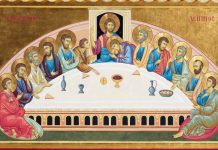
JANET SCHAEFFLER, OP
Artistic expression is at the core of who we have been as Church for our entire history: icons, stained-glass windows, poetry, journals, music, dance, paintings, sculpture, drama, etc. Artistic expression, of all kinds, needs to be part of faith formation today. The question is: which activities are most meaningful? Include these nine necessary ingredients for successful activities:
1. Teach the main idea
In faith formation, we are leading young people to the meaning of Scripture, beliefs, spirituality, Catholic social teaching, etc. As catechists, we help learners delve deeper into the meaning. Remember to include the core teaching in the activity.
2. Blend in catechetical and educational value
Activities deepen the learner’s understanding or appreciation by illuminating the truth, the implications of the belief, and the relevance of faith. Use technology or other resources that are used in their other classes.
3. Explain the purpose
Catechists don’t dream things up just to keep children busy. Activities and projects need to flow from the theme and reinforce the core teaching.
Vary the time in the lesson to incorporate an activity or project. For example, at the beginning of the lesson, do the project and use it as a focal point or during the closing prayer service.
4. Require the child to take ownership
The essence of an activity is self-expression: how does this apply to my life? Therefore, there is no need for samples to illustrate “what it has to look like.” No rules for “it has to be this way.” Because the activity helps the students deepen, not just repeat the learning, it goes a step beyond “presentation.”
5. Encourage personal, unique creativity
Invite children to say just enough to spark their thoughts, but leave them with freedom so that they can imagine, reflect, and apply. Do activities that allow children to express their feelings.
6. Allow various expressions
Introduce children to new types of media, employing various creative expressions of our rich Church heritage.
7. Suggest options
Children have different abilities and interests. Let children choose which option appeals to them, whether it is painting, writing, or using technology.
8. Relate to everyday life
Catechetical sessions are never an end in themselves. They send children forth to a new life of discipleship, prayer, witness, and to service. All learning answers the “so what?” question. What does this truth, doctrine, belief, practice of our heritage have to do with my everyday life?
9. Utilize the full potential of each activity
Even though the process (what happens within) is more important than the finished product, children quickly figure out what is and what is not busy work by the way catechists care for and take an interest in their work. Make the project useful.
Janet Schaeffler, OP is involved in catechetical/adult faith formation, consultation, writing, workshops, days of reflection/retreats, and teaching. Her website is janetschaeffler.com.
This article originally appeared in RTJ’s creative catechist September 2013.
Photo: Wavebreakmedia, istock




